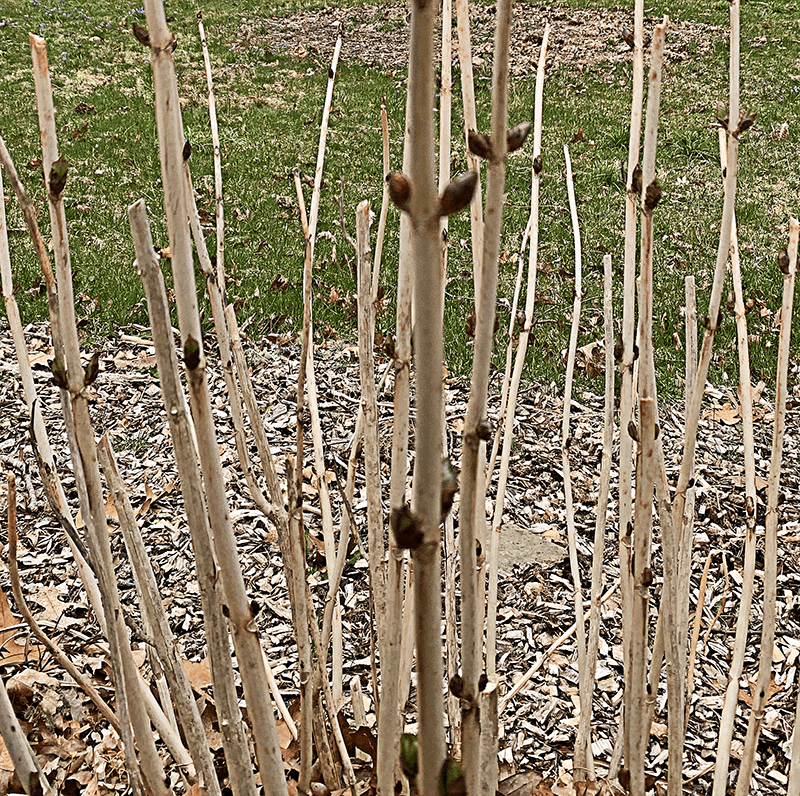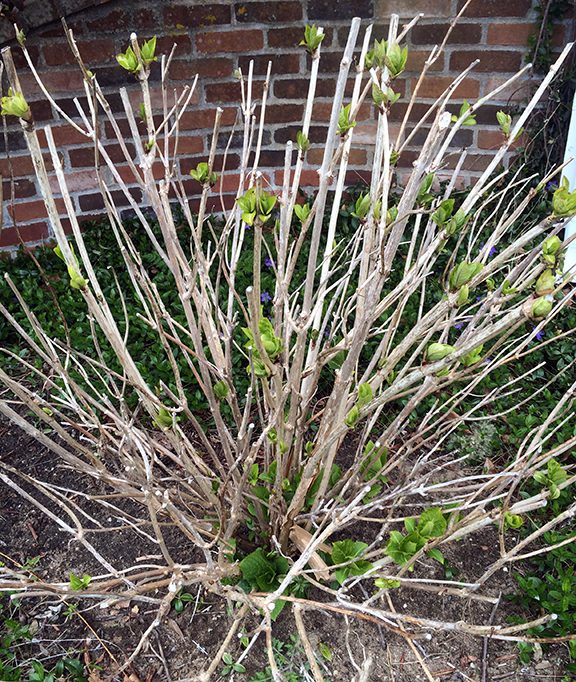Hydrangea Report – Spring 2014
Hydrangea Report – Spring 2014
We predict that the question of the summer on Cape Cod will be “Why aren’t my hydrangeas blooming?” The short answer is “Because it got so cold this winter,” and the photos below tell the story.


If your hydrangeas have died to the ground remove all canes that show no growth by mid-May. In our experience, if the blackened buds haven’t started to open by then they are not likely to, even if the bud or cane shows a hint of green. The plants will still grow just as tall as they were the previous year…this die-back won’t make a plant smaller.
Endless Summer and other hydrangeas that flower on new and old wood should produce some flowers on the new growth later in the summer, but you won’t have the normal display that starts in June. Hydrangeas that always bloom on new growth such as ‘Annabelle’ and ‘Limelight’ will bloom as normal; cold winter temperatures won’t alter their flowering.
For mop-head hydrangeas that have died back, an application of composted cow manure around the base of the plant and a light feeding with a fertilizer such as Holly-tone will make the plant happy. Home landscapers will need to console themselves with the gardener’s mantra: “There’s always next year.”
23 Comments
Leave a Comment
Subscribe To Our Newsletter
Sign up for our weekly email about sales and events.

Great information! That is what I suspected. What about lace cap hydrangeas?
Most lace caps are just like other blue and pink hydrangeas, Timothy – they bloom either only on old wood or a combination of old and new growth. So any lace cap hydrangea that doesn’t have leaves by mid-may should get cut to the ground. Prune off dead tips of other canes to just above the first set of leaves you come to from the top down to clean the shrub up. After that, we all have to just hope for a milder winter next year!
Thanks for the information. I knew that my plants were not up to snuff this year. Now I know why. Like you say-“always next year.”
Wondering why the hydrangea on the right did better??? Did you notice the downspout next to it, that delivered to it all the water the roof had to offer. My hydrangeas along the (desertlike) road have failed, but the ones near the house (and downspouts) have flourished.
Mike,
In general, the plants in colder spots or with more exposure got toasted. Plants in warmer or more protected locations were better off. My plants (in Sandwich, with cold wind off a pond) are filled with dead canes and I’ll have very few flowers. I’ve visited gardens closer to the south shores in Harwich Port and Chatham, however, that have many buds and good growth on them. My guess is that the plant pictured on the left was more exposed to the cold wind (it was on the water-side in this garden) and the plant on the right was shielded somewhat. This might be totally off-base, however. It could also be that the plant on the right is just slightly more bud-hardy in it’s natural constitution.
I am so glad to have read your newsletter tonight. I spent two housr careful cutting to the ground so much dead stem my plants look terrible. But as the saving goes “it just isn”t ONLY in my background’ !
Thank you for the answers to many of my Hydrangea questions! Helpful and needed! My next step is to further inspect my plants that were groomed earlier & most possibly need a little more “TLC”
I too, thank you for those tips on the Hydrangea plants. Mine also look like those photos, and some are better than others. I will get out there and prune them, but have been afraid to do anything to my 13 plants. I have several varieties, and the pink flower ones, are the slowest to show any green, but have long dead stems. Is there anything special I should do for them, other than the comments above.
Linda,
Other than pruning out all canes that have no opening leaves at this point, the best thing you can do is a light application of an organic fertilizer (you can’t go wrong with Holly-tone), followed by an inch of composted manure under and just beyond the dripline, and an inch or two of mulch. If it doesn’t rain at least an inch a week from now on, a deep soaking that delivers that amount of moisture every 7 days will be the best thing you can do.
CL!
Always great information! Thank you so much for the comprehensive report!
Best,
Love
Thank you so much for this information! Now I know why some of my plants have buds and some don’t.
Someone once told me to put my coffee grounds at the base of hydrangeas because the acidity would be good for them. Is that a myth or will it really help?
Thank you!
Claudine,
The truth is that most of the acid comes out of coffee when it’s brewed. Not only that, but as organic matter decomposes the pH comes to neutral, so even if you start off with acidic ingredients as they break down the chemical process brings it all to near neutral. The first thing to do is to have a pH test of the soil done by the local cooperative extension. If your soil needs to be more acidic for hydrangea “blues” then use sulfur – the soil test will tell you how much to apply.
Hello – Thank you for this information. I was wondering the same thing about my oak leaf hydrangeas. The leaves are beautiful, the plants look lush, but have very few blooms. When is the best time to prune them to ensure heavy blooms for the following season?
The best thing to insure flowers next season on an oakleaf is not to prune at all except for removing deadwood. Like many of the big leaf hydrangeas, these plants form their flower buds a year in advance so just about any time you prune them you’ll be removing the flowers for next year.
Thank you. My plants do get relatively large and I want to ‘contain’ them somewhat. Other than removing the deadwood in the spring, is there an ideal time to cut them back or a point to cut each stem back to that wouldn’t affect the blooms for next season?
You will find that no matter when you cut hydrangeas back you will have fewer flowers and the plants will once again be just as tall by August. They replace their height in one season. There are short varieties available at Country Garden 😉
Thank you, again! One more question: I have four St. Johns Wort plants that die back, basically, to the ground in the winter. I cut-back any dead stems in March/April before it starts to regrow. By now it looks pretty leggy and I’m wondering if I can/should prune it in the summer, also? Please let me know the best way to go about this or if I should leave it alone. Thank you!
It’s getting a little late but if you want to cut a third of the height off now it should be fine.
Thank you!!
I am hoping you can help. I have 10 year old lace cap hydrangeas. Like everyone else,they had a tough winter which left little growth on old canes. The few canes which were not removed had bloomed but slowly the leaves had wilted, turned yellow and died. What could be the cause. Thank you in advance for your help.
Sandi – I had the same thing happen on one of my lace caps. I think that these older canes had enough energy to start to produce new growth, but not enough to ultimately power the full growth and development of the stems and flowers. Once the new growth started up from the base these older, weaker canes just petered out as the plant then switched all resources into the new, vital growth. I had to go back and remove all those older canes and their yellowing growth that didn’t have the “umph” to continue. Let’s hope this winter is more mild!
I planted mop head flower kind plant last summer .. I live in canada so needless to say the winter was brutal.. I had covered the plant with burlap..now all it is old and dried canes and no sign of green.. What should I do… Should I prune them .. Someone told me plant is dead get rid of it.. I don’t have the heart.. Although an amateur at gardening I love my plants.. Should I wait till end of may to see if anything happens or really take the unpleasant advice?
Any input will be appreciated
Thank you
Aparna
Aparna
These plants really aren’t hardy in Canada, even in a mild winter. If you don’t see green growth from the ground by the end of May you’ll know it’s gone. In the future you could grow one in a pot and put that pot in a garage or other building where it doesn’t go much below freezing and grow the plant that way. And come down to Cape Cod some summer and celebrate hydrangeas with us here! If you come enjoy the Cape in July, we have a Hydrangea Festival where private gardens are open to the public. Should you ever make it down be sure to stop into our store to say hello.